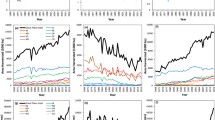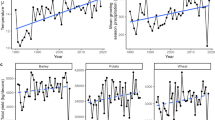Abstract
We used simple and explicit methods, as well as improved datasets for climate, crop phenology and yields, to address the association between variability in crop yields and climate anomalies in China from 1980 to 2008. We identified the most favourable and unfavourable climate conditions and the optimum temperatures for crop productivity in different regions of China. We found that the simultaneous occurrence of high temperatures, low precipitation and high solar radiation was unfavourable for wheat, maize and soybean productivity in large portions of northern, northwestern and northeastern China; this was because of droughts induced by warming or an increase in solar radiation. These climate anomalies could cause yield losses of up to 50 % for wheat, maize and soybeans in the arid and semi-arid regions of China. High precipitation and low solar radiation were unfavourable for crop productivity throughout southeastern China and could cause yield losses of approximately 20 % for rice and 50 % for wheat and maize. High temperatures were unfavourable for rice productivity in southwestern China because they induced heat stress, which could cause rice yield losses of approximately 20 %. In contrast, high temperatures and low precipitation were favourable for rice productivity in northeastern and eastern China. We found that the optimum temperatures for high yields were crop specific and had an explicit spatial pattern. These findings improve our understanding of the impacts of extreme climate events on agricultural production in different regions of China.



Similar content being viewed by others
References
Alexander LV, Zhang X, Peterson TC, Caesar J, Gleason B, Klein Tank AMG et al (2006) Global observed changes in daily climate extremes of temperature and precipitation. J Geophys Res Atmos 111:D05109. doi:10.1029/2005JD006290
Asseng S, Foster IAN, Turner NC (2011) The impact of temperature variability on wheat yields. Glob Change Biol 17:997–1012. doi:10.1111/j.1365-2486.2010.02262.x
Asseng S, Ewert F, Martre P, Rotter RP et al (2015) Rising temperatures reduce global wheat production. Nat Clim Change 5:143–147. doi:10.1038/nclimate2470
Battisti DS, Naylor RL (2009) Historical warnings of future food insecurity with unprecedented seasonal heat. Science 323:240–244. doi:10.1126/science.1164363
Challinor AJ, Wheeler TR, Craufurd PQ, Slingo JM (2005) Simulation of the impact of high temperature stress on annual crop yields. Agric For Meteorol 135:180–189. doi:10.1016/j.agrformet.2005.11.015
China Meteorological Administration (2009) Grade of chilling damage for rice and maize. Meteorological industry standard of People’s Republic of China (QX/T 101-2009). Beijing: China Meteorological Press. Delivered June 7, 2009, Implemented November 1, 2009
Coumou D, Rahmstorf S (2012) A decade of weather extremes. Nat Clim Change 2:491–496. doi:10.1038/nclimate1452
Craufurd PQ, Wheeler TR (2009) Climate change and the flowering time of annual crops. J Exp Bot 60:2529–2539. doi:10.1093/jxb/erp196
Fang S, Cammarano D, Zhou G, Tan K, Ren S (2015) Effects of increased day and night temperature with supplemental infrared heating on winter wheat growth in North China. Eur J Agron 64:67–77. doi:10.1016/j.eja.2014.12.012
Fu C, Wen G (1999) Variation of ecosystems over East Asia in association with seasonal, interannual and decadal monsoon climate variability. Clim Change 43:477–494. doi:10.1023/A:1005471600483
Hartmann DL, Klein Tank AMG, Rusticucci M, Alexander LV, Brönnimann S, Charabi Y, Dentener FJ, Dlugokencky EJ, Easterling DR, Kaplan A, Soden BJ, Thorne PW, Wild M, Zhai PM (2013) Observations: atmosphere and surface. In: Climate change 2013: the physical science basis. Contribution of working group I to the fifth assessment report of the intergovernmental panel on climate change. Cambridge University Press, Cambridge, United Kingdom and New York, NY
Iizumi T, Sakuma H, Yokozawa M, Luo J, Challinor AJ, Brown ME, Sakurai G, Yamagata T (2013) Prediction of seasonal climate-induced variations in global food production. Nat Clim Change 3:904–908. doi:10.1038/nclimate1945
Jagadish SVK, Craufurd PQ, Wheeler TR (2007) High temperature stress and spikelet fertility in rice (Oryza sativa L.). J Exp Bot 58:1627–1635. doi:10.1093/jxb/erm003
Ju H, van der Velde M, Lin E, Xiong W, Li Y (2013) The impacts of climate change on agricultural production systems in China. Clim Change 1–2:313–324. doi:10.1007/s10584-013-0803-7
Li QX, Dong WJ (2009) Detection and adjustment of undocumented discontinuities in Chinese temperature series using a composite approach. Adv Atmos Sci 26:143–153. doi:10.1007/s00376-009-0143-8
Li Z, Yan ZW (2009) Homogenized daily mean/maximum/minimum temperature series for China from 1960–2008. Atmos Ocean Sci Lett 2:237–243
Li Y, Xiong W, Hu W, Berry P, Ju H, Lin E, Wang W, Li K, Pan J (2015) Integrated assessment of China’s agricultural vulnerability to climate change: a multi-indicator approach. Clim Change 128:355–366. doi:10.1007/s10584-014-1165-5
Liu B, Henderson M, Xu M, Zhang Y (2011) Observed changes in precipitation on the wettest days of the year in China, 1960–2000. Int J Clim 31:487–503. doi:10.1002/joc.2089
Liu Y, Yang X, Wang E, Xue C (2014) Climate and crop yields impacted by ENSO episodes on the North China Plain: 1956–2006. Reg Environ Change 14:49–59. doi:10.1007/s10113-013-0455-1
Lobell DB, Schlenker W, Costa-Roberts J (2011) Climate trends and global crop production since 1980. Science 333:616–620. doi:10.1126/science.1204531
Lobell DB, Sibley A, Ortiz-Monasterio JI (2012) Extreme heat effects on wheat senescence in India. Nat Clim Change 2:186–189. doi:10.1038/nclimate1356
Lobell DB, Hammer GL, McLean G, Messina C, Roberts MJ, Schlenker W (2013) The critical role of extreme heat for maize production in the United States. Nat Clim Change 3:497–501. doi:10.1038/nclimate1832
Manton MJ, Della-Marta PM, Haylock MR, Hennessy KJ et al (2001) Trends in extreme daily rainfall and temperature in Southeast Asia and the South Pacific: 1961–1998. Int J Climatol 21:269–284. doi:10.1002/joc.610
Matsui T, Omasa K, Horie T (2000) High temperature at flowering inhibits swelling of pollen grains, a driving force for thecae dehiscence in rice (Oryza sativa L.). Plant Prod Sci 3:430–434
Porter JR, Xie L, Challinor AJ, Cochrane K, Howden SM, Iqbal MM, Lobell DB, Travasso MI (2014) Food security and food production systems. In: Climate change 2014: impacts, adaptation, and vulnerability. Part A: global and sectoral aspects. Contribution of working group II to the fifth assessment report of the intergovernmental panel on climate change, Cambridge University Press, Cambridge, United Kingdom and New York, NY, pp 485-533
Salinger MJ, Stigter CJ, Das HP (2000) Agrometeorological adaptation strategies to increasing climate variability and climate change. In: Sivakumar MVK, Stigter CJ, Rijks DA (eds) Agrometeorology in the twenty-first century needs and perspectives, vol 103, pp 167–184
Sánchez B, Rasmussen A, Porter JR (2014) Temperatures and the growth and development of maize and rice: a review. Glob Change Biol 20:408–417. doi:10.1111/gcb.12389
Shi W, Tao F (2014) Spatio-temporal distributions of climate disasters and the response of wheat yields in China from 1983 to 2008. Nat Hazards 74:569–583. doi:10.1007/s11069-014-1197-1
Shuai J, Zhang Z, Liu X, Chen Y, Wang P, Shi P (2013a) Increasing concentrations of aerosols offset the benefits of climate warming on rice yields during 1980–2008 in Jiangsu province, China. Reg Environ Change 13:287–297. doi:10.1007/s10113-012-0332-3
Shuai J, Zhang Z, Sun DZ, Tao F, Shi P (2013b) ENSO, climate variability and crop yields in China. Clim Res 58:133–148. doi:10.3354/cr01194
Tao F, Zhang Z (2013) Climate change, high temperature stress, rice productivity and water use in Eastern China: a new super-ensemble-based probabilistic projection. J Appl Meteorol Climatol 52:531–551. doi:10.1175/JAMC-D-12-0100.1
Tao F, Yokozawa M, Zhang Z, Hayashi Y, Grassl H, Fu C (2004) Variability in climatology and agricultural production variability in China in association with East Asian monsoon and El Niño Southern Oscillation. Clim Res 28:23–30. doi:10.3354/cr028023
Tao F, Zhang Z, Zhang S, Zhu Z, Shi W (2012) Response of crop yields to climate trends since 1980 in China. Clim Res 54:233–247. doi:10.3354/cr01131
Tao F, Zhang S, Zhang Z (2013) Changes in rice disasters across China in recent decades and the meteorological and agronomic causes. Reg Environ Change 13:743–759. doi:10.1007/s10113-012-0357-7
Tao F, Zhang Z, Zhang S, Rötter RP (2015) Heat stress impacts on wheat growth and yield were reduced in the Huang-Huai-Hai plain of China in the past three decades. Eur J Agron 71:44–52. doi:10.1016/j.eja.2015.08.003
Wang S, Huo Z, Guo J, Wang C (2005) Agrometeorological disaster risk management in China. In: Das HP, Sivakumar MVK, Motha RP (eds) Natural disasters and extreme events in agriculture. Springer, Heidelberg, pp 241–258
Wang P, Zhang Z, Song X, Chen Y, Wei X, Shi P, Tao F (2014) Temperature variations and rice yields in China: historical contributions and future trends. Clim Change 124:777–789. doi:10.1007/s10584-014-1136-x
Xiong W, Holman I, You L, Yang J, Wu W (2014) Impacts of observed growing-season warming trends since 1980 on crop yields in China. Reg Environ Change 14:7–16. doi:10.1007/s10113-013-0418-6
Zhai PM, Zhang XB, Pan XH (2005) Trends in total precipitation and frequency of daily precipitation extremes over China. J Clim 18:1096–1108. doi:10.1175/JCLI-3318.1
Zhang T, Huang Y (2013) Estimating the impacts of warming trends on wheat and maize in China from 1980 to 2008 based on county level data. Int J Climatol 33:699–708. doi:10.1002/joc.3463
Zhang S, Tao F (2013) Modeling the response of rice phenology to climate change and variability in different climatic zones: comparisons of five models. Eur J Agron 45:165–176. doi:10.1016/j.eja.2012.10.005
Zhang J, Zhang J, Yao F, Men Y, Gao X (2013) Effects of free air temperature increasing on the rice growth and grain yield in Northeast China. Chin J Ecol 32:15–21
Zhang Z, Wang P, Chen Y, Zhang S, Tao F, Liu X (2014) Spatial pattern and decadal change of agro-meteorological disasters in the main wheat production area of China during 1991–2009. J Geogr Sci 24:387–396. doi:10.1007/s11442-014-1095-1
Zhang Z, Song X, Tao F, Zhang S, Shi W (2015) Climate trends and crop production in China at county scale, 1980–2008. Theory Appl Climatol. doi:10.1007/s00704-014-1343-4
Acknowledgments
This study is supported by the National Science Foundation of China (Project Nos. 41571088, 31561143003 and 41571493), partly supported by the Finnish Ministry of Agriculture and Forestry via FACCE-MACSUR and by Luke via the strategic MODAGS project. We are grateful to two anonymous reviewers for providing highly valuable comments on earlier drafts of this manuscript.
Author information
Authors and Affiliations
Corresponding author
Additional information
Editor: Wolfgang Cramer.
Electronic supplementary material
Below is the link to the electronic supplementary material.
10113_2015_920_MOESM1_ESM.pdf
Fig.S1. Anomalies of wheat yield (A, E), mean temperature (B, F), precipitation (C, G) and solar radiation (D, H) in the five lowest yielding years (A, B, C, D) and the five highest yielding years (E, F, G, H) during 1980-2008 (PDF 5251 kb)
10113_2015_920_MOESM2_ESM.pdf
Fig.S2. Anomalies of maize yield (A, E), mean temperature (B, F), precipitation (C, G) and solar radiation (D, H) in the five lowest yielding years (A, B, C, D) and the five highest yielding years (E, F, G, H) during 1980-2008 (PDF 5243 kb)
10113_2015_920_MOESM3_ESM.pdf
Fig.S3. Anomalies of soybean yield (A, E), mean temperature (B, F), precipitation (C, G) and solar radiation (D, H) in the five lowest yielding years (A, B, C, D) and the five highest yielding years (E, F, G, H) during 1980-2008 (PDF 5132 kb)
Rights and permissions
About this article
Cite this article
Tao, F., Zhang, Z., Zhang, S. et al. Variability in crop yields associated with climate anomalies in China over the past three decades. Reg Environ Change 16, 1715–1723 (2016). https://doi.org/10.1007/s10113-015-0920-0
Received:
Accepted:
Published:
Issue Date:
DOI: https://doi.org/10.1007/s10113-015-0920-0




